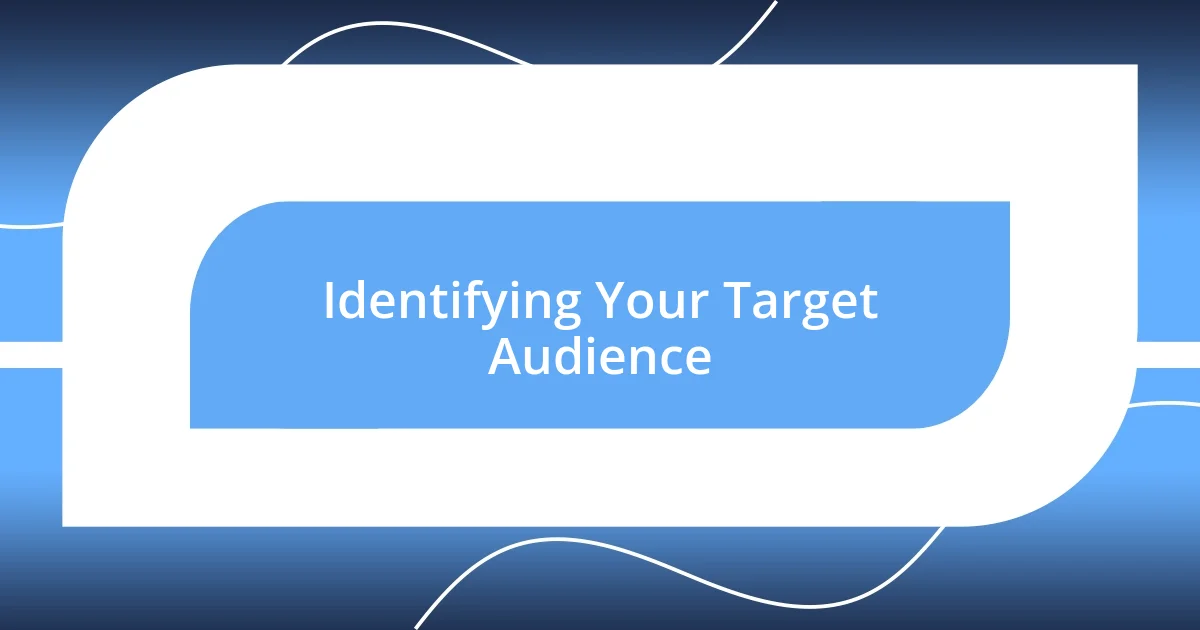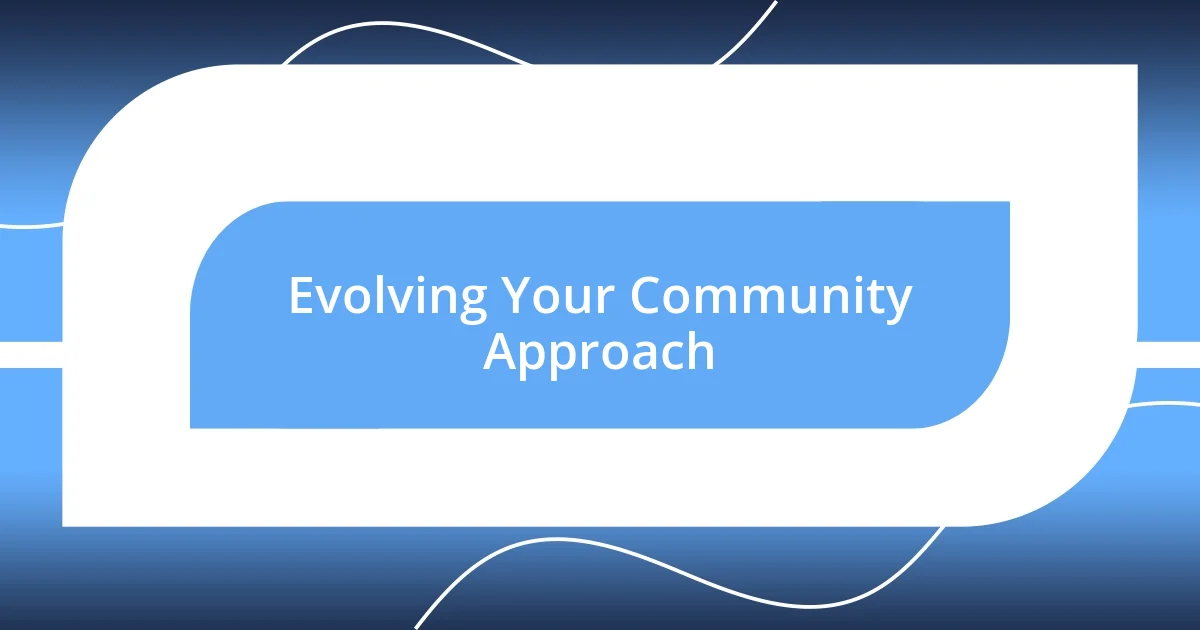Key takeaways:
- Community building thrives on fostering genuine connections through shared interests, values, and active participation.
- Defining clear, inclusive community goals and measuring them regularly enhances accountability and engagement among members.
- Leveraging both online platforms and flexible, open approaches helps sustain active community interactions and adapt to members’ evolving needs.

Understanding Community Building
Understanding community building goes beyond simply gathering people in one space; it’s about fostering genuine connections. I remember my first experience with a community project where we all shared our stories. It was fascinating to see how opening up about our experiences not only created bonds but also paved the way for trust and collaboration.
Have you ever thought about what actually makes a community thrive? I’ve learned that it often hinges on common interests and values, but also on the feeling of belonging. Just a few weeks ago, I joined a local group focused on sustainable living. The initial hesitance melted away when I realized everyone shared a passion for creating a greener world. We all felt seen and heard, reinforcing the idea that shared missions ignite community spirit.
Another important aspect of community building is active participation. I once volunteered at a community garden, and this hands-on approach was incredibly rewarding. The smiles, laughter, and shared work turned strangers into friends. Such interactions illustrate how collaboration fuels not just growth in a garden, but growth in relationships as well. Isn’t it incredible how little seeds of participation can sprout into a flourishing community?

Defining Your Community Goals
Defining community goals is foundational to any successful initiative. In my experience, it’s crucial to establish clear, specific objectives that resonate with the community members. For instance, during a previous project aimed at improving local art accessibility, we set a goal to increase participation in workshops by 50% within a year. This type of goal not only directs efforts but also fosters a sense of accountability among participants, creating a shared mission.
It’s also essential to consider the diversity of your community when defining goals. I’ve learned that taking time to listen to various voices can dramatically shape the direction your community takes. I remember hosting a brainstorming session where everyone contributed ideas for upcoming events. The range of perspectives not only enriched our vision but, surprisingly, led us to host an intercultural festival that became an annual highlight. Community goals should reflect the collective aspirations, ensuring that every member feels included and valued.
Lastly, measuring and revisiting these goals is just as important. Have you ever set a goal that later felt too ambitious or even misaligned with your community’s evolving needs? I certainly have; it was humbling to reevaluate our objectives based on community feedback. By revisiting our goals regularly, we created a more dynamic and responsive community that truly thrived in collaboration with its members.
| Type of Goal | Description |
|---|---|
| Participation Goals | Targets for involvement, such as increasing attendance at events or workshops. |
| Engagement Goals | Focuses on enhancing active involvement of members in discussions, activities, or decision-making processes. |
| Diversity Goals | Goals aimed at ensuring representation and inclusiveness of different community voices and identities. |
| Feedback Goals | Establish regular intervals for gathering community input to refine and adjust goals. |

Identifying Your Target Audience
Identifying your target audience is a vital step that I learned through trial and error. I remember launching a neighborhood book club and initially inviting everyone I knew. To my surprise, it wasn’t a hit. It took some reflection to understand that if I had tailored my invitation to people who were passionate about reading, we would have had a more engaged and vibrant group. Focusing on shared interests makes all the difference.
To accurately identify your target audience, consider these pivotal aspects:
- Demographics: Age, gender, income level, and education can influence interests and participation.
- Interests and Values: Understanding what excites or concerns your community can guide engagement strategies.
- Engagement Channels: Determine where your audience spends their time, whether it’s social media, local events, or online forums.
- Needs and Aspirations: Take the time to listen to what your community hopes to achieve. This can reveal motivations behind why they would want to join your initiative.
By focusing on these areas, I’ve found a real connection with my community, transforming vague invitations into meaningful engagement.

Creating Engagement Strategies
Creating effective engagement strategies begins with understanding that interaction is a two-way street. In one of my earlier community projects, we hosted a casual coffee chat where everyone shared their thoughts and ideas. The atmosphere was warm and open, which encouraged even the shyest members to speak up. Reflecting on that experience, I realized how important it is to provide a safe space for genuine dialogue. Have you ever been in a situation where you felt empowered to share your voice? That’s the kind of environment we should strive to create.
Another approach that has proven successful is leveraging online platforms to foster engagement. I once started a Facebook group for pet owners in my neighborhood. The initial spark was simple—sharing pictures of our furry friends. But slowly, it evolved into something much more significant; it became a hub for advice, support, and even organizing pet meetups. This experience taught me that sometimes, all it takes is a small idea to ignite a larger conversation. How can you tap into online resources to enhance your community interactions?
Lastly, I believe in mixing traditional and innovative methods to keep the engagement alive. For instance, I’ve found that pairing community surveys with engaging events yields fantastic results. At one point, we hosted an open-door event featuring local artists, paired with a digital feedback system. This not only sparked enthusiasm but also generated valuable insights about our community preferences. It’s interesting to see how vibrant participation can emerge when you combine creativity with strategic gathering of input. Have you tried blending different approaches in your engagements? The outcomes can be quite revealing.

Leveraging Online Platforms
Leveraging online platforms has become essential in today’s community-building efforts. I recall launching an Instagram account dedicated to my local gardening group. At first, I thought it would simply showcase beautiful flowers, but it quickly blossomed into a virtual community where members shared tips, solutions for pest problems, and even organized plant swaps. Seeing people engage from different backgrounds, united by a common interest, was incredibly rewarding. Have you noticed how a simple photo can spark a conversation that leads to lasting connections?
It’s fascinating how diverse online platforms can cater to various community needs. For example, I’ve experimented with Discord for organizing virtual meetups, especially during the pandemic. This platform allowed us to create different channels for topics ranging from DIY projects to sharing upcoming local events. I often reflect on how the ease of creating these subgroups fostered deeper conversations among attendees. Isn’t it amazing how technology can bridge gaps and form closer bonds among us?
Moreover, I’ve observed that utilizing platforms like Meetup or Eventbrite can amplify physical gatherings. Once, I posted an event on Meetup for a community cleanup, and I was astounded by the number of participants who showed up—many of whom I hadn’t met before. Their enthusiasm reiterated the notion that when we leverage these digital tools effectively, we can mobilize people who share passions. How have online platforms shaped your community interactions? Exploring these avenues can often leave us pleasantly surprised.

Measuring Community Success
Measuring community success is an integral part of understanding the impact of our efforts. One of my favorite methods has been tracking participant engagement through simple metrics like attendance, comments, and shares. For instance, after hosting a monthly skill-sharing workshop, I noticed not just increased attendance, but members actively began reaching out to each other outside of the events. This kind of organic interaction tells me we’re on the right path—wouldn’t you agree that genuine connections are a sign of a thriving community?
Another approach I’ve embraced is collecting feedback directly from community members. I once distributed a quick, informal survey after a neighborhood potluck, asking participants what they loved and what could improve. The responses were eye-opening; people shared unexpected ideas for future gatherings and ways to support one another. This experience highlighted that listening is just as crucial as creating and nurturing—a lesson I carry into every project. Have you ever been surprised by the insights your community offers when you simply ask?
Finally, I believe qualitative stories can be just as powerful as the numbers. I’ve seen firsthand how individual testimonials can illustrate our community’s impact. After a volunteer event, one participant shared how the experience revitalized her sense of belonging in the area. That emotional connection is something you can’t measure in data alone. Isn’t it rewarding to realize that sometimes, the most profound success indicators come from heartfelt stories? It’s these narratives that nourish our commitment to building strong, supportive communities.

Evolving Your Community Approach
Evolving one’s approach to community-building often draws from past experiences and new insights. I once revamped my strategy after realizing that our monthly meetings were losing steam. Instead of sticking to a rigid agenda, I introduced an open floor segment where everyone could share their thoughts and suggestions. It was incredible to witness the shift—people became more invested, and our gatherings sparkled with fresh ideas. Have you ever noticed how sometimes, stepping back and letting your community lead can breathe new life into your initiatives?
As I’ve navigated through different community dynamics, I’ve learned that flexibility is key. Last year, we decided to switch our weekend clean-up events to weekday evenings based on feedback. Initially, it felt like a gamble, but the turnout was overwhelming; we attracted not just regulars, but newcomers eager to contribute. I often reflect on how adapting to your members’ schedules can strengthen the community bond. What changes have you made that ultimately enhanced your group dynamics?
In this ever-evolving landscape, staying curious about your community’s needs is essential. I’ve recently started hosting casual coffee chats where we can gather in a relaxed setting and talk about what truly matters to us. This approach opened the door to heartfelt conversations about personal stories and challenges that often go unspoken. I wonder, how often do we create spaces for vulnerability and connection? The evolution of our community approach lies not just in structured events but in fostering an environment where everyone feels they can contribute to the conversation.














